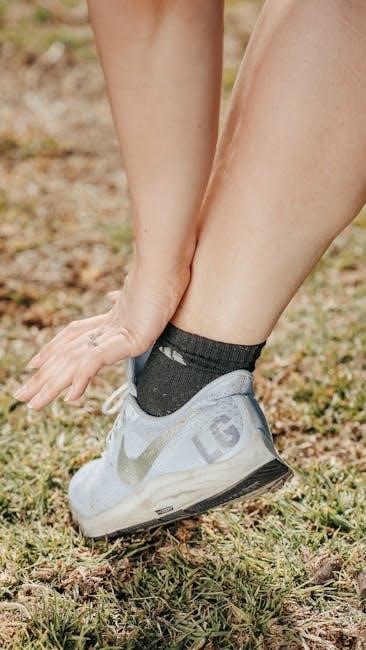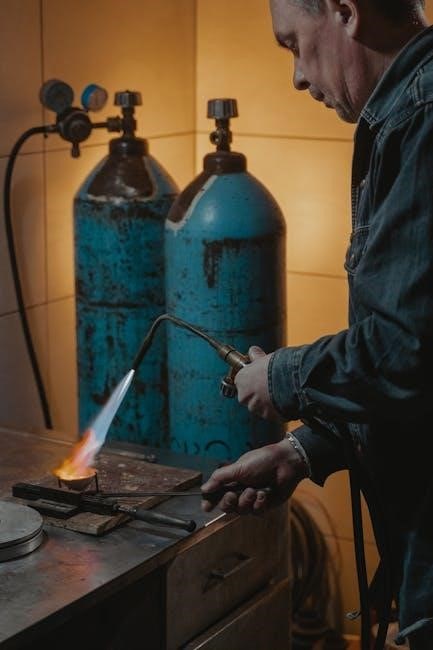Paracord bracelets are versatile, practical accessories with a rich history, offering both survival functionality and fashionable appeal. They’ve become popular DIY projects, combining creativity with utility, perfect for outdoor enthusiasts and crafters alike.
1.1; What is a Paracord Bracelet?
A paracord bracelet is a versatile accessory made from durable nylon paracord, often used for survival and outdoor activities. It serves as both a stylish accessory and an emergency tool, storing cord that can be unraveled for various purposes. Its practicality and customization options make it a popular DIY project.
1.2. Benefits of Making a Paracord Bracelet
Making a paracord bracelet offers multiple benefits, including learning valuable survival skills, creating a customizable accessory, and having a reliable emergency tool. It’s also a fun, cost-effective DIY project that can be personalized with different colors and patterns, making it a practical and creative endeavor for enthusiasts of all skill levels.

Materials and Tools Needed
To make a paracord bracelet, you’ll need high-quality 550 paracord, a sturdy buckle, scissors, and a lighter. Optional tools include a measuring tape and board for precision.
2.1. Paracord (Type and Length Requirements)
Use high-quality 550 paracord for durability, with a minimum breaking strength of 550 lbs. For a basic bracelet, 8-10 feet is recommended, while complex designs like the King Cobra require 18-20 feet. Length depends on wrist size and design complexity.
2.2. Buckle or Clasp
A sturdy buckle or clasp is essential for securing the bracelet. Popular options include adjustable shackles, side-release buckles, and metal clasps. Ensure the buckle is durable and appropriate for the bracelet’s intended use, whether for survival or fashion purposes.
2.3. Scissors and Lighter
Sharp scissors are necessary for cutting paracord cleanly, while a lighter is used to melt the ends, preventing fraying; These tools ensure professional finishes and durability, making them indispensable for crafting sturdy, long-lasting paracord bracelets.
2.4. Optional Tools (Measuring Tape, Board, etc.)
A measuring tape and cutting board are optional but helpful tools. They assist in accurately measuring paracord lengths and keeping your workspace organized. These tools enhance precision and efficiency, making the crafting process smoother and more enjoyable for both beginners and experienced makers.

Understanding Basic Knots and Stitches
Mastering essential knots like the Lark’s Head and Cobra Stitch is crucial for crafting durable and stylish paracord bracelets. These foundational techniques ensure both functionality and aesthetic appeal, forming the backbone of every design.
3.1. Lark’s Head Knot
The Lark’s Head Knot is a fundamental starting point for paracord bracelets. It involves folding the cord in half, attaching it to a buckle or loop, and securing it with a simple overhand knot. This knot is essential for initiating the bracelet’s structure and ensuring a secure fit.
3.2. Cobra Stitch
The Cobra Stitch is a popular pattern for paracord bracelets, known for its strength and durability. It involves crossing strands over and under each other, creating a textured, woven design. This stitch is ideal for survival bracelets, as it can be easily unraveled for emergency use while maintaining a stylish appearance.
3.3. Half Hitch Knot
The Half Hitch Knot is a simple yet essential knot used to secure ends of paracord, ensuring a neat finish. It’s often used to start or end a bracelet and can be incorporated into various patterns. This knot is easy to learn, making it a great starting point for beginners.
Choosing a Design
Selecting a design for your paracord bracelet depends on your skill level and desired aesthetic. Popular options like Cobra, Fishtail, and King Cobra patterns offer variety and style, catering to both beginners and advanced crafters.
4.1. Cobra Paracord Bracelet
The Cobra Paracord Bracelet is a popular and stylish design, made using durable paracord. It’s ideal for both everyday wear and survival situations. This design is perfect for beginners, as it’s easy to create and offers a sleek, woven pattern that looks great on any wrist.
4.2. Fishtail Paracord Bracelet
The Fishtail Paracord Bracelet is a visually striking design that incorporates two colors, creating a unique and intricate pattern. It’s slightly more complex than the Cobra bracelet but offers a beautiful, woven aesthetic. Step-by-step guides make it accessible for crafters of all skill levels, ensuring a professional finish every time.
4.3. King Cobra Paracord Bracelet
The King Cobra Paracord Bracelet is a striking, two-color design that adds an extra layer of complexity to the classic Cobra pattern. It requires approximately 18-20 feet of 550 paracord and features an adjustable shackle. This design stands out for its intricate texture and bold appearance, making it a favorite among paracord enthusiasts. Step-by-step instructions ensure even beginners can craft this unique accessory with ease.

Step-by-Step Instructions
Begin with a Lark’s Head Knot, measure cord length for your wrist, and fold it in half. Cross the cords to create patterns, tighten knots, and finish with a secure knot.
5.1. Preparing the Paracord
Pre-shrink the paracord by soaking it in water, then drying. Measure and cut the cord based on wrist size, typically 1 foot per inch of wrist circumference. Fold the cord in half, securing it with a Lark’s Head Knot to form the base of the bracelet.
5.2. Starting the Bracelet
Attach the paracord to the buckle using a Lark’s Head Knot. Hold the folded cord at the base and begin weaving the first knot, ensuring it’s snug but not overly tight. This sets the foundation for the bracelet’s pattern and ensures a secure fit.
5.3. Adding Knots and Patterns
Start by creating a Cobra Stitch, looping the cord under and over alternately. Tighten each knot firmly to maintain consistency. For a Fishtail, weave the cord through the center and pull tight. Experiment with different knots and colors to achieve unique designs, ensuring each step follows the pattern sequence precisely.
5.4. Finishing the Bracelet
Trim excess paracord with scissors and melt the ends with a lighter to prevent fraying. Ensure all knots are tightly secured for durability. Adjust the bracelet to fit your wrist comfortably. Finally, tuck the ends under the knots and apply a small dab of wax or charm for a polished finish.

Tips and Tricks
Pre-shrink paracord before use and apply wax to knots for extra security. Regularly clean your bracelet to prevent dirt buildup and extend its lifespan.
6.1. Avoiding Common Mistakes
Avoid uneven knots by ensuring consistent tension while weaving. Prevent loose stitches by tightly pulling each knot. Measure paracord accurately to avoid running out mid-project. Use a lighter carefully to avoid burning the cord. Keep tools organized to maintain focus and efficiency during the process.
6.2. Adjusting the Bracelet Size
Measure your wrist to determine the ideal length. A general rule is 1 inch of bracelet length equals 1 foot of paracord. For an 8-inch wrist, use 8-10 feet of cord. Adjust by loosening or tightening knots and ensure a snug, comfortable fit. Use an adjustable buckle for versatility.
6.3. Using Different Colors and Patterns
Experiment with color combinations to add visual appeal. Use two-tone designs for a striking look or match colors to personal preferences. Try patterns like the Cobra Stitch or Fishtail for uniqueness. Alternate knots and cord wrapping techniques to create intricate designs. Pre-shrink paracord to ensure consistent sizing and durability.
Advanced Techniques
Explore two-color designs, bead integration, and complex patterns like the Dragon Teeth knot for unique styles. These methods enhance both functionality and aesthetic appeal of paracord bracelets.
7.1. Two-Color Paracord Bracelet
A two-color paracord bracelet combines contrasting hues for visual appeal. Using 4 feet of one color and 10 feet of another, this design involves intertwining strands to create intricate patterns. The process includes folding cords, tying knots, and securing ends with a buckle or loop for a polished finish.
7.2. Adding Beads or Charms
Enhance your paracord bracelet by incorporating metal, plastic, or ceramic beads for aesthetic or symbolic value. Beads can be threaded onto the cord before knotting or added later by weaving the paracord through them. Spacer beads help maintain structure, while decorative charms add personality and functionality to the design.
7.3. Adjustable Buckle Techniques
Adjustable buckles offer customization, allowing bracelets to fit various wrist sizes. Techniques include using a shackle or side-release buckle, enabling easy resizing. Secure the buckle with a stop knot and ensure proper alignment for a snug, comfortable fit. This method enhances functionality while maintaining the bracelet’s aesthetic appeal.

Safety Precautions
Handle heat tools like lighters carefully to avoid burns. Use scissors safely and keep fingers away from sharp edges. Ensure proper ventilation when melting paracord ends.
8.1. Handling Heat Tools
When using heat tools like lighters, exercise caution to avoid burns. Keep flammable materials away and ensure the area is well-ventilated. Hold the lighter steadily, melting paracord ends smoothly to prevent uneven edges. Avoid prolonged exposure to heat to maintain tool and paracord integrity.
8.2. Working with Sharp Objects
Handle scissors and sharp tools with care to prevent injuries. Always cut away from your body and keep fingers away from blades. Store sharp objects securely when not in use to avoid accidents. Ensure a safe working environment and maintain focus while trimming paracord ends or adjusting materials.
8.3. Avoiding Injuries
Always use caution when handling sharp objects and heat tools. Wear protective gear like gloves to prevent cuts and burns. Ensure tools are in good condition and keep your workspace clear. Stay focused and follow instructions to minimize risks and avoid accidents during the crafting process.
Additional Resources
Explore printable PDF guides, video tutorials, and online forums for detailed step-by-step instructions. These resources offer comprehensive support, from basic to advanced techniques, ensuring success in crafting your paracord bracelet.
9.1. Printable PDF Guides
Download detailed step-by-step paracord bracelet instructions in PDF format. These guides offer clear diagrams and tutorials, perfect for beginners and experienced crafters. Find specific patterns like the Dragon Teeth knot or Basic Cobra Bracelet tutorials for easy reference and offline use.
9.2. Video Tutorials
Explore numerous video tutorials on platforms like YouTube, offering step-by-step paracord bracelet instructions. From basic patterns like the Dragon Teeth knot to complex designs, these videos provide clear, visual guidance. Perfect for visual learners, they feature close-ups and detailed explanations to help you master various techniques effortlessly.
9.3. Online Communities
Join online forums and groups dedicated to paracord crafting, where enthusiasts share ideas, tutorials, and inspiration. Platforms like Facebook groups or specialized forums offer spaces to connect with creators, showcase your work, and gain feedback. These communities are invaluable for learning new techniques and staying updated on trends in paracord bracelet making.
Creating a paracord bracelet is a rewarding project that combines creativity with practicality. With patience and practice, you’ll master various designs, fostering a sense of accomplishment and inspiration to craft more.
10.1. Final Tips for Success
For a successful paracord bracelet, ensure accurate measurements, tighten knots firmly, and pre-shrink paracord. Practice basic knots like the Lark’s Head and Cobra Stitch. Use clear tutorials and patience, especially for intricate designs, to achieve professional results and durability in your finished piece.
10.2. Encouragement to Create
Creating a paracord bracelet is a rewarding DIY project that combines creativity with practicality. Whether for personal use or as a gift, each bracelet tells a story. Don’t be afraid to experiment with colors and patterns—every stitch is a step toward something unique and meaningful. Embrace the process and enjoy crafting!

